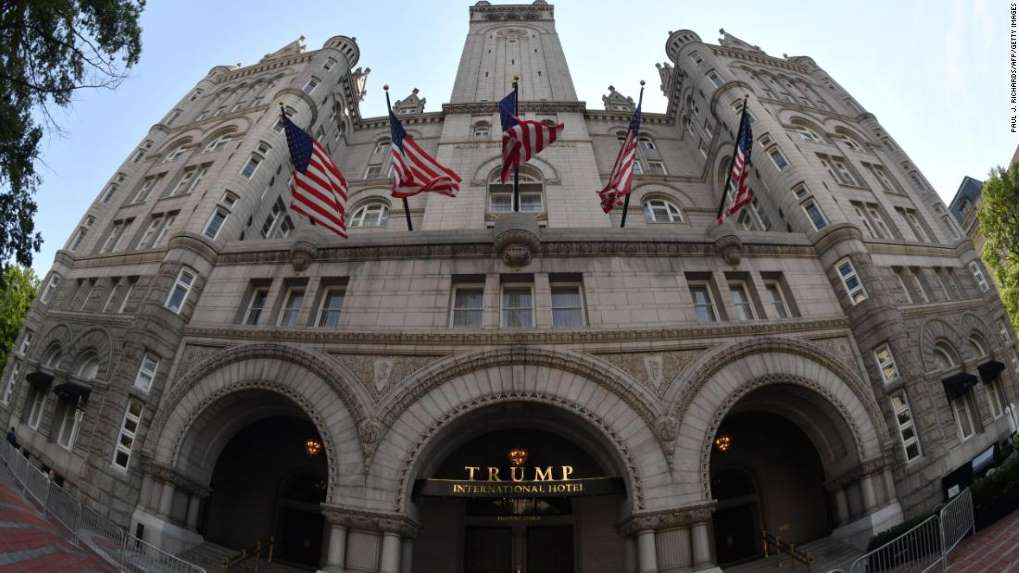February 26, 2018

President Trump’s assertion that he would have run toward the Parkland, Fla., gunman had he been near the school would have been a bold claim for just about anybody to make.
“I really believe I’d run in, even if I didn't have a weapon,” he said during a meeting at the White House on Monday.
February 26, 2018

President Trump’s assertion that he would have run toward the Parkland, Fla., gunman had he been near the school would have been a bold claim for just about anybody to make.
“I really believe I’d run in, even if I didn't have a weapon,” he said during a meeting at the White House on Monday.
Trump has no background in law enforcement or the military, and the boastful nature of the statement — the president was nowhere near the shooting when it occurred — immediately raised questions about his intent.
And given Trump’s public track record in the face of proximate danger, his words instead ended up underscoring an conflicting truth: his actions haven't always matched his tough talk.
Spooked at a rally
The most frightened that Trump has ever seemed in public was perhaps a moment during a campaign rally in Dayton, Ohio, in March 2016.
The then-candidate was in the midst of speaking about manufacturing, when a man hopped the barrier behind him and rushed the stage. Trump stopped speaking, looked nervously behind him and grabbed and started to duck behind his lectern.

Trump covers himself from the rain with an umbrella while his son, Barron Trump, walks behind as they board Air Force One in West Palm Beach, Fla., after a holiday weekend in January.
He was then swarmed by Secret Service agents, who steadied him.
Trump continued his speech after the disruption, and gave the audience a thumbs up, claiming that he could have handled the attacker himself, despite his first reaction.
“I was ready for him,” Trump said, “but it’s much easier if the cops do it.”
A Secret Service agent suffered a minor injury in the episode and the suspect, who police identified as Thomas Dimassimo, was arrested and charged with two misdemeanors.
The moment was later immortalized in a doctored video in which a seated Bernie Sanders yelling “boo” was edited into the frame the moment before Trump was spooked.
Later that year at another rally, Trump was hustled off a stage in Nevada, after the someone in the audience yelled “gun.” No weapon was found.
An eagle named Uncle Sam
In 2015, Trump was beat out by Angela Merkel for Time magazine’s Person of the Year. But as a runner-up (the magazine said he was third, behind ISIS leader Abu Bakr al-Baghdadi), he was still given a write-up and photo shoot for the magazine.
Time paired him with a 27-year-old bald eagle named Uncle Sam during the shoot, but the bird didn’t want to stay still, flapping its wing so hard it blew his hair as it sat on Trump’s gloved hand. And in the midst of a separate pose photographers arranged with Trump at his desk and the bird perched beside him, Uncle Sam lunged at Trump as he went to grab something near its feat.
Trump quickly shrunk away from the bird, recoiling so far that he nearly fell out of the camera frame.

“We’re not doing it again, don’t worry,” Trump told the crew. “What you will do for a cover. This bird is seriously dangerous, but beautiful.”
The Vietnam War
Trump’s detractors call him “Cadet Bone Spurs” for his failure to serve in the Vietnam War though he was of age, and they have some facts on which to ground their epithet.
While 9 million Americans served in the military during the Vietnam War — 1.8 million were drafted — the future president was given five deferments from the draft: four related to his college studies and one for bone spurs in his heel, though the problem was not severe enough to prevent him from playing sports such as football, tennis and golf as a young man.
For years, Trump had explained his lack of service by the luck of a high lottery number.
The year of Trump’s graduation from the University of Pennsylvania’s Wharton School, 1968, was the bloodiest for American troops of the war: about 16,900 soldiers were killed that year. By the time the war ended in 1975, 58,000 Americans had died.
In contrast, special counsel Robert S. Mueller III, whose investigation into Russian interference Trump routinely maligns, chose to enlist in the Marine Corps and was deployed to Vietnam to lead a rifle platoon that year, earning two awards for valor and suffering a gunshot wound to his leg.
Decades later, Trump told radio host Howard Stern that avoiding sexually transmitted diseases was “my personal Vietnam.”
“I feel like a great and very brave soldier,” Trump said.
Blood, germs and feels
Trump, who has a reputation as a germaphobe, has spoken about his fear of contamination for years. He told Stern about his penchant for hand-washing and drinking through straws, saying he was concerned about glasses being dirty and the cleanliness of other people’s hands.
He also told the radio host that he was terrified of blood.
“I’m not good for medical,” he said in a 2008 interview. “In other words, if you cut your finger and there’s blood pouring out, I’m gone.”
He told Stern about an old man falling from the stage during a benefit at his Mar-a-Lago club.
“I said, ‘Oh my God, that’s disgusting,’ and I turned away,” Trump said. “I didn’t want to touch him … he’s bleeding all over the place, I felt terrible. You know, beautiful marble floor, didn’t look like it. It changed color. Became very red. And you have this poor guy, 80 years old, laying on the floor unconscious, and all the rich people are turning away. ‘Oh my God! This is terrible! This is disgusting!’ And you know, they’re turning away. Nobody wants to help the guy.”
Trump said that Marines at the benefit came to the aid of the fallen man, and the future president kicked into action.
“I was saying, ‘Get that blood cleaned up! It’s disgusting!’ ” said Trump. “The next day, I forgot to call to say he’s okay.”
No-go zones
For decades, presidents have visited troops overseas at least once a year, especially during their first year in office. Vice President Pence went to Afghanistan on Trump’s behalf before Christmas, and visited troops who are fighting ISIS in Syria and Iraq at an undisclosed military base last month.
But Trump has yet to visit a combat zone despite the United States’ military entanglements overseas.
In an editorial that urged the president to visit a war zone, USA Today writer Gregg Zoroya noted the risks involved, pointing out that the Kabul airport where Defense Secretary Jim Mattis flew into in September had come under intense rocket attack that resulted in civilian deaths.
“Most of the time, these trips produce little political payoff. News coverage is scant. Most Americans back home are asleep during the visit,” Zoroya wrote. “It’s also a long way to travel with living conditions far less accommodating than the White House or a luxury Florida resort like Trump's Mar-a-Lago.”
Trump also waited nearly two weeks to visit hurricane-ravaged Puerto Rico last October, then made a series of remarks that some saw as gaffes.
“I’ve been to Puerto Rico many times . . . and I’ve always loved it,” he said in his remarks. “And your weather is second to none, but every once in a while you get hit.”
Trump has talked exceedingly tough on North Korea, to the chagrin of some foreign-policy experts, but a highly touted trip to the demilitarized zone between North and South Korea in November — all but one president since Ronald Reagan has made the pilgrimage — was canceled at the last minute because of hazy skies.
A month after the launch of his presidential campaign, he made a show of visiting the border near Laredo, Tex., repeatedly talking up the danger of the visit. “I may never see you again, but we’re going to do it,” he told Fox News.
His trip to Laredo — a news conference at an airport hotel and a brief visit to the bridge connecting the city to Mexico — lasted less than three hours. Laredo is one of the safest cities in Texas, and has a lower murder rate than Trump’s hometown, New York City.
‘You never stand in front of the door’
During an interview with The Washington Post in 2016, Trump spoke about collecting rent from buildings his father owned in “dangerous” areas, like Coney Island, Brooklyn and Cincinnati where he said he was “liable to get shot” if he came at the wrong time.
“You know when you collect rent — and you may have heard this — but you never stand in front of the door,” Trump said. “And you always knock this way because you get bad things coming through that door.”
Courtesy/Source: Washington Post
















































































































